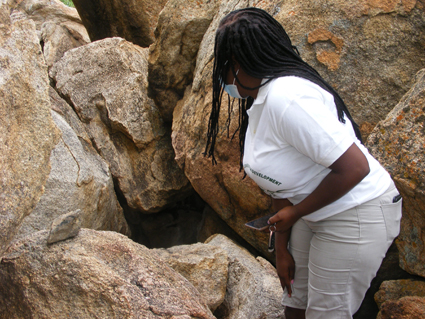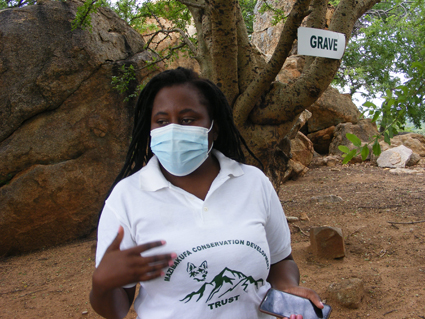Mazibakufa protecting mortals from death
17 Jan 2022
Mazibukufa Conservation Trust in Jackalas No 1 is looking at ways through which it can generate income from the village’s historical site.
Mazibakufa hills, which are said to be ‘siblings’ do not only tell the popular mythical tale of the village and its ruins; they also offer insight into the history of the village and how it transitioned to civilisation.
Indicators of past life such as kraals and graves have been found on the ruins.
The mother hill is situated a stones throw east of Ramakgwebana border post while two of its siblings stand aloof and tall toward the Zimbabwean border.
The mother hill, as put by one member of Mazibukufa Conservation Trust Ms Hanani Khupe is the subject of many fascinating stories and adventures.
The hill houses a kraal, a mass grave of women believed to be of high significance, some caves with what is believed to be human bones, sand bags allegedly used by the military during the Rhodesian war.
Ms Khupe explained that Mazibukufa ruins have been declared a protected heritage.
She said most of the information had not been documented and people often doubted its authenticity despite the ruins being historical.
“These are not just ordinary ruins. Each hill tells a story that explains a way of life for some people who resided there many years ago.
Just like, Domboshaba ruins in Masunga, Mazibukufa ruins is a cultural and heritage site originally occupied towards the end of the great Zimbabwe period.
We want to turn these ruins into a tourist attraction to generate revenue,” she said.
The idea, she said, was to host cultural events, weddings and other celebratory gatherings at a fee to help the Trust generate some income.
Ms Khupe who spoke passionately about each ruin and the significance of protecting the hills said no scientific research had been done, despite overwhelming oral evidence passed from one generation to the other.
The Mazibukufa hills gives one a refreshing view of nearby land marks such as the Jackalas No 1 dam to the west, Zimbabwe Immigration offices, Jackalas No 1 and Ramakgwebana villages, the Gandanyemba ruins as well as the Ramokgwebana river which forms the border line between Botswana and Zimbabwe as it meanders on its easterly sojourn.
“History has it that some people stayed at the top of the hills during the Ndebele wars. From there they could see their enemies from afar.
That explains how the hills came to be called Mazibakufa, which in isiNdebele means protection from death,” she said. But more intriguing information emerge as one climbs the hill.
First you’re warned not to take anything you find on the hill as it has been placed there for research purposes.
At the summit of the hill sits a lone grave. It is believed to be that of a pregnant woman who was either the wife to the chief, a traditional doctor or a traditional leader.
“We’ve concluded that the bones belonged to a woman who we have believe might have been a person of high significance or even a wife of a king because of where we found the remains,” she explained.
Near the grave are caves with numerous bones that are also believed to be of humans who were buried here according to the ancient African belief of burying people between rocks or atop hills.
“These remains are expected to tell a story and hopefully explain who these people are – and if they are human remains or not.”
Ms Khupe explained those who settled at the top might have designed the kraal or central point.
“We call this kraal a prime area because of the uniquely designed pieces of pottery believed to have been used by the chief’s assistant or wives,” she said.
On the same prime area, are bags of sacks filled with sand sticking out of the ground like a giant whale.
The bags were clearly been buried here many years ago.
These she said were placed by the Botswana Defence Force (BDF) who used them as stop buds during the African’s war for independence against Rhodesia’s Ian Smith.
Ms Khupe said the BDF was working with them to research about the military’s their own history around the site.
Going down the hill, is a tall, big tree known as The Famous Fig Tree named so owing to several mentions of the fig tree in the Bible.
The second hill, steeper and more difficult to climb, is known as the haunt for traditional doctors. “Traditional healers were initiated on top of this hill, and oral evidence suggests the hill is held in high esteem, so much so that rituals are performed here,” she said.
In fact it is believed that Ngwali, the Kalanga God of rain first resided on this hill before relocating to Mbalambi village.
The third hill, said Ms Khupe, is equally mystical.
The hill has some overlapping rocks with pods that can hold lots of water, during the rainy season, and remaining full throughout year.
It is said that those who lived nearby used them as bathtubs. ENDS
Source : BOPA
Author : Gofaone Mapugwa
Location : JACKALAS NO 1
Event : Mazibukufa Conservation Trust
Date : 17 Jan 2022








